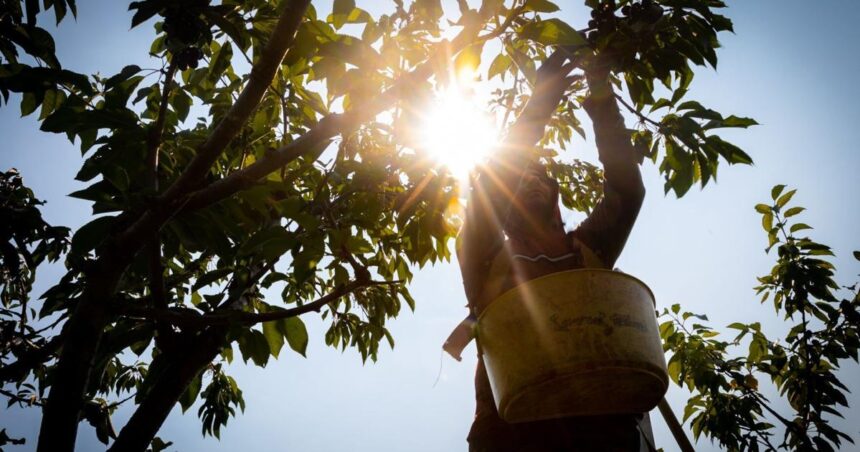FLATHEAD LAKE — The famous Flathead cherry crop in western Montana got almost completely wiped out this year by a hard freeze in January, which one longtime grower called the worst she’s seen in a quarter century.
Large and small cherry orchards dot the landscape along Flathead Lake, mainly on the east side, because the lake’s enormous volume of water usually moderates the temperature enough to allow the delicate cherry buds to thrive during the Montana winters.
Luis Ortiz gracefully picks the outer branches of a Flathead cherry tree in August 2021. The Flathead cherry crop in western Montana was almost completely wiped out by a hard freeze in January 2024.
Each year, Flathead Lake growers produce between 2 million and 3 million pounds of the fruit. The Flathead cherries are valuable because they usually come later in the season than the huge crops from Washington and other places, meaning customers will pay a premium for those fresh cherries into late July and August.
But the mid-January freeze this year means there will be no millions of pounds, and probably not even thousands of pounds, of cherries.
People are also reading…
Tiffany Sybert of Cherrywood Orchard off Highway 35 on the east side of the lake said her roughly 850 trees usually produce between 18,000 and 20,000 pounds a year.
“We’ll be lucky if we harvest 50 pounds total,” she explained. “There was a warmup in January and then we were hit with an Arctic freeze that lasted about a week, and we lost our sweet cherry crops for the 2024 season. Very few blooms survived. It just killed the buds, so our trees are fine. So we’re going to experiment with new processes and think about what we’re gonna do going forward and we’re super excited for next year. We’re just going to roll with Mother Nature.”
Up and down the lake, it was the same story.
The answering machine message for the Flathead Lake Cherry Growers cooperative is grim:
“If you are looking for cherries this year, we are sorry to report that due to a damaging freeze in January, the majority of trees suffered bud damage and will not produce cherries,” the message states. “Harvest is usually mid-July to early August and there may be a few roadside stands who are be able to find enough fruit to open the stands, but the crop is well short of anything normal.”
Pamela Stoddard of Stoddard Orchard said it was the worst freeze she’s seen in 25 years. She noted that there’s hundreds of people who will be out of work for the summer, including migrant Latino cherry pickers and all the people who operate sprayers for the orchards and manage the trees for the owners.
“I was sad I wasn’t going to get a crop and I’m not going to have fun summer orchard time, but for those who depend on it as a livelihood, that’s devastating,” Stoddard explained.
She said one of her friends told her the last time a hard freeze wiped out the crop this badly was sometime in the late ’60s.
“It was just an odd winter,” she said. “Because it was late freezing also. So what the winter didn’t kill, those spring days that dropped below 30 did it.”
Stoddard estimated that the temperature dropped to about 30 degrees below in January.
“All my neighbors all the way up and down the east shore had the same thing happen,” she said. “I’ve heard the orchards closer to Polson fared a bit better.”






